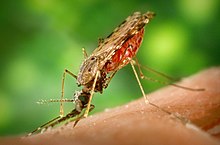Climate change in Colorado
In 2019 The Denver Post reported that "[i]ndividuals living in southeastern Colorado are more vulnerable to potential health effects from climate change than residents in other parts of the state".
Throughout the western United States, heat waves are becoming more common, snow is melting earlier in spring, and less water flows through the Colorado River.
In the coming decades, the changing climate is likely to decrease water availability and agricultural yields in Colorado, and further increase the risk of wildfires".
The upward movement of the tree line will shrink the extent of alpine tundra and fragment these ecosystems, possibly causing the loss of some species".
[6] "Throughout the West, much of the water needed for agriculture, public supplies, and other uses comes from mountain snowpack, which melts in spring and summer and runs off into rivers and fills reservoirs.
Such a change is significant because the river supports 40 million people's water consumption throughout the West and $1 trillion in economic activity.
A collaboration between Boulder County Parks and Open Space and Colorado State University is working to develop techniques to improve soil health and carbon sequestration.
Higher evaporation rates will increase irrigation demands and reduce natural recharge of the aquifer, further lowering the water table.
[6] "Higher temperatures and drought are likely to increase the severity, frequency, and extent of wildfires in Colorado, which could harm property, livelihoods, and human health.
The Culex mosquito, the primary vector of WNV, lays its eggs in standing water and is most active during later, warmer summer conditions.
[14] Vector-borne diseases such as the West Nile Virus (WNV) are influenced by changes in weather conditions such as temperature, precipitation, and humidity, which create ideal breeding grounds for mosquitoes.
[15] Shifting hydrologic conditions can alter the incidence of vector-borne disease as an increase also affects the number of WNV cases seen.
[17] Although changes in climate and weather patterns have the ability to contribute to more frequent outbreaks of WNV, local environmental conditions also play a role.
In the year 1996, a fire burned nearly 12,000 acres around Buffalo Creek, which serves as the main source of the city's water supply.
Two months following this devastating wildfire, heavy thunderstorms caused flash floods in the burned area, having the effect of washing sediment into the city's reservoir.
Further, Denver has installed sensors in the reservoirs in order to monitor the quality of the water and quantity of debris or sediment.
These accomplishments will have the effect of building a more resilient Denver, Colorado towards the impending increase of extreme weather events such as wildfire and flooding.











